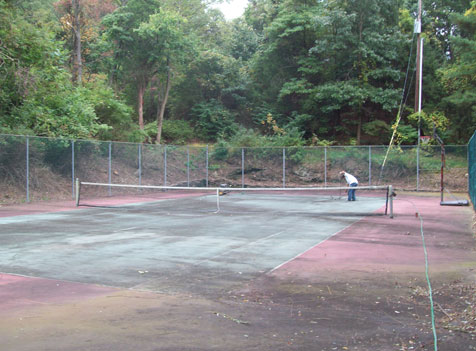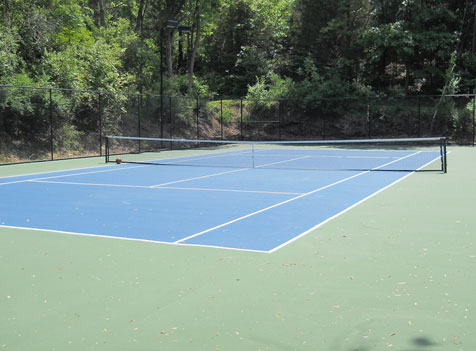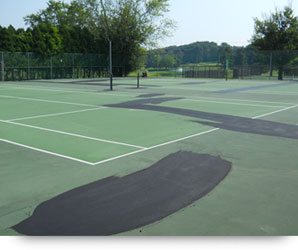
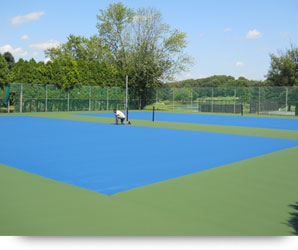
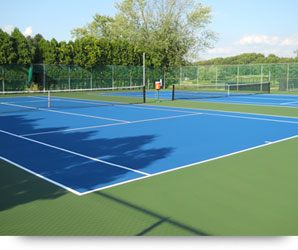
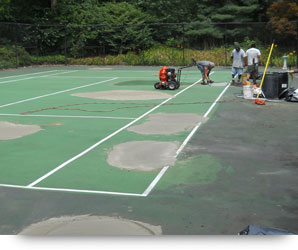
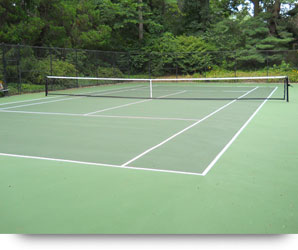
Hard Court Resurfacing
“Bring your court back to life. Who wants to play on a dirty cracked court?”
Tennis court resurfacing is actually a two-phase process that involves aggressive repair of the existing court structure ( called the “repair phase”) followed by the application of an acrylic coating system (called the “surfacing phase”). Due to seasonal freezing and thawing, even well-constructed hard courts will develop cracks and low spots and will require maintenance over time. We recommend a resurfacing procedure every five to seven years. It will restore the court's playability factors, vastly improve its appearance and extend the life of the court by preserving the integrity of the asphalt court base. The resurfacing procedure is to repair structural cracks found on the court surface with a flexible fabric membrane called the Tri-Force Crack Repair System and to level the court surface with cement skim coats to remove surface depressions. Following surface preparations, the court receives a new acrylic coating system, which reseals the asphalt, insulates and disguises the repair work, and restores surface texture while providing an attractive new court color scheme. Following resurfacing, Sport Builders can provide an annual maintenance program to keep the court in good shape. In fact, we have a crew dedicated to servicing Sport Builders customers. We pride ourselves on keeping your court safe, playable and looking good for years after the court has been resurfaced. Bottom line, if there is a problem on the court we will be there for you. Also, there are many exciting add-on options available to help you get the most out of your tennis court.
REPAIR PHASE
Resurfacing tennis courts begins a with a comprehensive repair process. Successful resurfacing depends on quality repair work that will last. In order to prepare the court for resurfacing, structural cracking is repaired with a concrete compound and supported with the Tri-Force Crack Repair System. This system helps prevent the cracks from returning to the surface by expanding and contracting with the movement of the crack. To improve playability, low spots and depressions are also repaired with cement skim coats. Surface leveling prevents water accumulation which can break down the components of the acrylic coating system. There are many other repairs such as perimeter corrections, removal and repair of old delaminated court material and high spot removal.
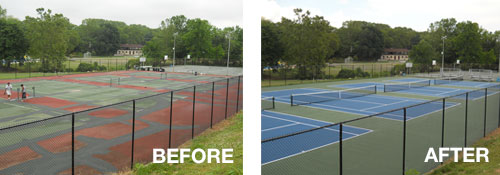
SURFACING PHASE
When tennis courts are resurfaced or surfaced for the first time, they are painted with a multi-layer paint system that seals the voids in the asphalt, creates surface texture and protects the asphalt from damage. Coating systems ultimately enhance overall playability and gives the surface a vibrant new color scheme. Bright white playing lines are the finishing touch to accentuate the color contrast between the center playing area and the perimeter of the court. Lines are always installed according to the United States Tennis Association specifications. Coating systems are applied with the use of hand held squeegees, an “old school” application technique that takes years to master. After a court has been resurfaced, additional color coats can be installed every 2-3 years to preserve surface playability and to keep the court looking new. For more information on Acrylic Coating Systems, visit Sealmaster or Plexipave. Sport Builders is an authorized installer of these surfacing systems.
CUSHIONED COATING SYSTEMS
A cushioned surface option is available. This system combines the same consistency and durability as the standard coating system but adds layers of rubber particles or "cushion" to absorb shock and reduce the impact on a player's body. It is primarily used for tennis courts; however, it can also be installed on basketball courts. Although there are several variations of a cushioned system, the ideal system features five layers of rubberized particles that are applied to the court surface after all repair work is completed. After each coat of rubber is installed (which creates the cushion system), the final color system is applied. When finished, the court looks and feels like a traditional hard court but the surface is much softer and easier on the body. Tennis players really feel the difference when changing direction as the surface absorbs movement impact and they also enjoy a slower pace of play.
